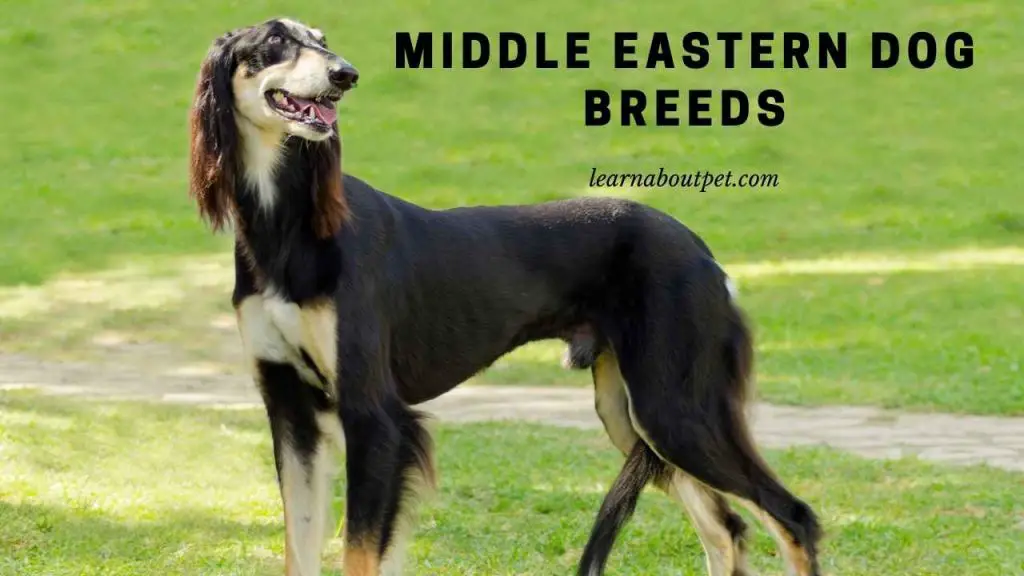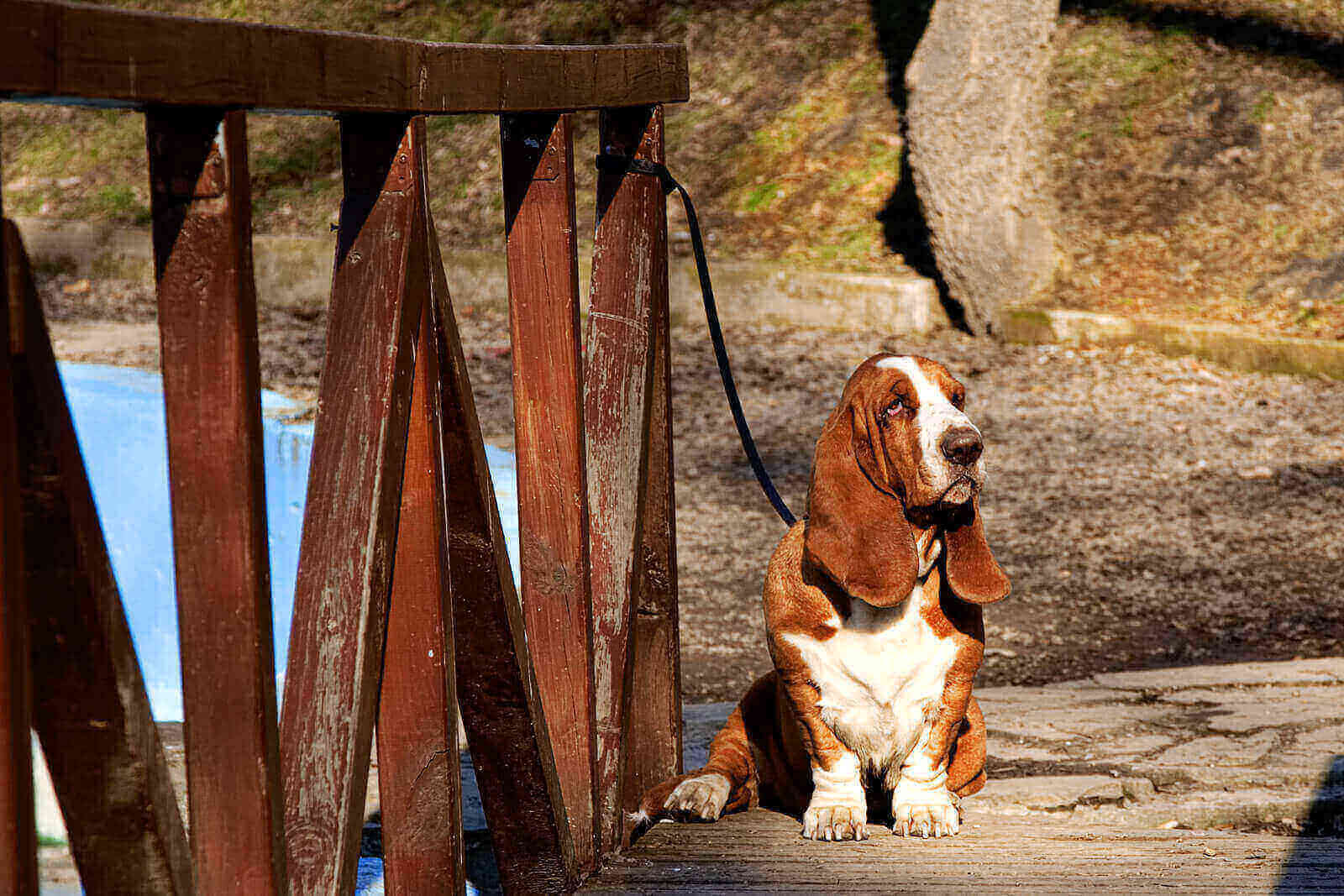Dogs were first domesticated between 12,000 and 10,000 BC. Nowadays, dogs are regarded as man’s best friend, and with good reason. Another interesting fact about dogs is that dogs’ brains have more than tripled in size over the last thirty thousand years.
Talking about canines and their character traits, what about when it comes to middle eastern dog breeds in particular?
The Middle East is home to a diverse range of dog breeds, many of which have been bred as working dogs and are still used as such. Some of these breeds, like the Saluki and the Afghan Hound are well known across the globe, while others remain unknown to most people outside the region.

Middle Eastern Dog Breeds
Simply put, middle eastern dog breeds were originally bred to be companions and help with hunting and guarding. The first dogs were domesticated from shared ancestors of modern wolves.
That said, it is well known that Middle Eastern dogs go back a long time, as evidenced by the fact that they have been uncovered in numerous archeological digs throughout the region.
Here are some breeds you might recognize
Afghan Hound
Like many Middle Eastern dog breeds, the Afghan Hound was originally bred for hunting. This breed is also known as the Tazi or Baluchi Hound, and is believed to be one of the oldest dog breeds in existence.
These dogs can run at speeds up to 40 miles per hour, and are known for their remarkable jumping ability. One of the most recognizable features of this breed is its long silky coat, which requires a lot of grooming.
Saluki
Another hound breed developed for hunting, the Saluki is said to date as far back as 329 B.C., when Alexander The Great found a pack of these dogs during his Persian campaign. They were used by nomadic tribesmen to hunt hare and gazelle in Iran (or Persia) and Egypt.
What Is An Arabian Dog?
As part of the middle eastern dog breeds, Arabian dogs are one of the oldest types of dogs that exist. They are thought to have originated in the middle east and were used by nomadic people to herd animals like sheep and goats. The original name for these dogs was “Al Khabara” which means “the guard dog” in Arabic.
These dogs were not only guardians of herds but also protectors of their owners, who lived a nomadic lifestyle. The first record we have about these types of dogs is from the 6th century BC, when they were mentioned in writings from Assyrian traders who had visited Egypt and brought back some specimens with them.
Talking of what arabic dogs are, what about when it comes to Arabian hunting dog description? The Arabian Hunting Dog, or Arabian Hound, is a breed of dog that was originally bred to hunt gazelles, hares and foxes. It was bred in the deserts of Arabia and it also served as a guard dog to protect the families and their homes.
The Arabian hunting dog is a medium sized animal that has long legs, an elongated head and neck, with a long tail that is carried with a slight curve on its back.
What Are Dogs Used For In The Middle East?
Dogs have long been a part of Middle Eastern cultures, but they have traditionally not been treated as pets. Instead, they are primarily used for hunting and security purposes, though some dogs are also kept to guard camels and sheep.
These canines must be tough to handle the harsh desert environment and the bounty of predators that live there. They guard the livestock from jackals, hyenas and cheetahs, as well as from thieves who may want to steal their herds.
Guard dogs are usually large in size, sometimes standing at over 3 feet tall and weighing over 100 pounds. Their ability to see in the dark and hear very well helps them protect their flocks during quiet desert nights.
In addition to guarding livestock, these desert-living dogs help hunters track down prey. They travel with the hunters on horseback or even camelback to catch rabbits, gazelles or foxes. These hunting dogs can also be used against larger game such as bears or wolves.
Middle Eastern Dog Breeds
Dog breeds throughout the Middle East are as varied as they are attractive. These have been bred to hunt, herd and guard livestock and homes. Some of these dogs, like the Canaan Dog (considered a national symbol of Israel), also work in search-and-rescue and as guide dogs for the blind.
Some of the most popular breeds of Middle Eastern Dog breeds are : the Saluki, the Afghan Hound, the Basenji, the Borzoi, and the chow chow.
Talking of middle east dog breeds, what about when it comes to middle eastern dog breeds? In the Middle East, dogs aren’t just pets-they’re protectors. They are trained to be tough, watchful and obedient, making them perfect companions for families with young children.
The Saluki is the most popular of these breeds. It has a regal appearance, with sleek white fur and graceful legs that make it ideal for hunting. Its strong instincts give this breed an air of suspicion around strangers, but it is fiercely loyal to its family and will defend them from harm.
Another breed common in the Middle East is the Canaan dog, which looks similar to a coyote and is often trained as a guard dog. Like the Saluki, it can also be used as a hunting or search-and-rescue dog because of its superior sense of smell.
These breeds are prized for their ability to keep their human friends safe, especially in countries where crime and theft are more prevalent than in the U.S., but they also make fantastic family pets wherever you live.
Arabian Village Dogs
Arabian village dogs are a different breed of dog, when compared to their foreign counterparts. They can be seen running around the streets of our villages, mostly found in groups of four or five. They usually have no owner and live on their own in packs.
Arabian village dogs are not like other pets as they are not treated with affection, nor do they get any food from human beings. They survive by eating leftovers from garbage bins and leftover food from restaurants. They will even eat the dead animals that lie in the street or field that have been killed by cars or other animals.
Talking of Arabian village dogs, what about when it comes to middle eastern dogs, how do dogs from the middle east live? Do they also live like Arabian village dogs?
Dogs in the Middle East are well-treated animals that are fed and given water. However, there are no leash laws in the Middle East, so dogs can be seen running around on the street without a leash.
What about when it comes to Lebanese dogs? The Lebanese breeds are a group of dogs that were primarily developed in the mountainous areas of Lebanon, Turkey and Syria. Dogs from these areas were bred for their hunting skills and intelligence.
The most common breed is the Lebanese hound, which was originally bred as a sight hound. The dogs have been used to hunt jackals, gazelle, ibex, deer and pig. The breed is known for its agility, stamina and speed.

Middle Eastern Greyhound
The middle eastern greyhound is a breed that most people don’t know much about. This is unfortunate, as they are one of the most noble and loyal dog breeds in the world. They have been known to guard the homes of their owners while they’re away, and they can run faster than any other breed on foot.
Furthermore, middle eastern greyhounds have been trained by the military around the world for their speed and loyalty, and are prized for their ability to track down missing persons or lost items. In fact, they’re even better than some humans at tracking scents!
Talking of the middle eastern greyhound, what about when it comes to the syrian dog? The Syrian dog was a breed of domestic dog that was native to Syria. They were known for their fierce loyalty and intelligence.
The Syrian dogs were also used as guard dogs, though they were not an aggressive breed.
These dogs were playful and loyal, but they did not get along with other animals. Syrians were not allowed to keep dogs as pets, so they would typically hide them in their homes or in the streets.
What about when it comes to iraq dog breeds and their characteristics? The Iraqi dog breeds are a group of medium-sized dogs native to the Middle East. The Iraqi dog breeds can be divided into three types: the big hunting dogs, small scent hounds, and the largest livestock guarding dogs.
The Iraqi dog breeds were bred by the Sumerians, Babylonians and Assyrians of ancient Mesopotamia.
Large Middle Eastern Dog Breeds
Although the list of the largest dog breeds is full of impressive and imposing canines, there are a few Middle Eastern breeds that deserve a spot on the list. The Anatolian Shepherd, the Central Asian Shepherd, and the Kangal Dog are all large, working dogs that have been used in their home countries to guard livestock against wolves and other predators for centuries.
The Anatolian Shepherd comes from Turkey, where it was first used to protect livestock on the Anatolian Plateau. It has been bred for centuries to be a large, protective dog. The male can stand between 28 and 31 inches at the shoulder, with an average weight of around 150 pounds (some can even weigh up to 200 pounds!).
Females are slightly smaller, standing between 26 and 29 inches tall, with an average weight of 120 pounds. With a double coat that is both dense and long, these dogs are well suited for cold weather climates and have adapted easily to life in America’s northern states and Canada.
The Central Asian Shepherd comes from Russia, Turkmenistan, Uzbekistan, and Tajikistan. It has also been used for centuries as a working dog by nomadic shepherds who use them to guard their herds of sheep against wolves.
Ancient Middle Eastern Dog Breeds
Ancient Middle Eastern dogs were primarily bred for their ability to hunt, guard, and herd. Some of the most common breeds are the Canaan Dog, Afghan Hound, Basenji, Saluki, and Greyhound. These dogs have long been associated with humans, both as companions and workers; they’re even mentioned in ancient texts.
The Canaan Dog was originally a breed used to herd sheep and as a guard dog. They were also used in military operations-the Israeli Army used them in search-and-rescue missions.
Today they are still being used by the Israeli Army as well as by other branches of the military around the world for tasks such as detecting explosives or narcotics.
The Afghan Hound is a high-energy hunting dog that is known for its elegant appearance. It was originally bred in Afghanistan for hunting rabbits and other small animals. The breed was used extensively during World War II by British soldiers who needed to travel between Afghanistan and India quickly without horses or mules
These dogs could run up to 50 miles per day over rough terrain carrying 100 pounds of equipment! Amazing huh!
The Basenji is an African sighthound that is known for its long legs and short coat. They are playful dogs with high intelligence levels; these qualities make them great pets for.
Middle Eastern And African Dog Breeds
The dogs of the Middle East and Africa are very different from those you may meet in your own backyard. The tradition of keeping dogs in these regions dates as far back as ancient Greece, when the Assyrians used ferocious mastiffs to terrify their enemies.
Many people know about the Saluki, a graceful and fleet-footed dog from the Middle East that is often used for hunting. However, there are many other breeds native to this part of the world, including some that have been around for thousands of years.
Here are some you may not have heard of before:
The Canaan Dog is Israel’s national dog, originally bred by nomads for herding and guarding livestock. Nowadays, it’s often used for search and rescue missions.
The Basenji is a small hunting dog that hails from Central Africa; it has an unusual yodel-like bark instead of a full woof.
The Afghan Hound was bred as a hunter by Iranian aristocrats; it has an elegant appearance with long hair and a regal bearing.
The Sloughi, or Arabian Greyhound, was bred to chase down gazelles; its name actually means “hunter.”
Talking of middle eastern dog breeds, what about when it comes to Middle Eastern dog breeds? The Canaan dog, and the Palestinian Pariah Dog, is a breed of pariah dog that originated in the Middle East. The Canaan Dog is believed to be one of the oldest breeds of dog, being a descendant of the ancient Spitz-type dog.
Middle Eastern Fighting Dog Breeds
The Middle East is often associated with violence, but this doesn’t have to be the case. In fact, if you own a fighting dog breed, it can actually help deter violence in your home and neighborhood.
Moreover, it’s well known that these breeds are extremely intelligent and protective of their owners and property, so they’re an excellent choice for anyone who wants or needs a watchdog. You should also keep your dog away from small children or other pets, since it could attack them if it feels threatened.
The most common breed of fighting dog breed is the Pit Bull Terrier (American Staffordshire Terrier). This breed originated in England as fighting dogs until they were banned by the English government for use in sports such as rat-baiting and bear-baiting.
Nowadays, there are many different types of these dogs including the American Pit Bull Terriers (AmStaffs), English Staffordshire Bull Terriers (Staffys), and American Bulldogs which are often called “pit bulls” despite being unrelated genetically.
Pitbulls come in many different colors including brown, red or fawn colored coats with white markings on their chest and face area; brindle patterns; black patches over their eyes; light grey shading from head to rump; and black spots around the neck area.
Talking about mid easter fighting dog breeds, what about when it comes to middle eastern dog breeds? The Middle East is one of the oldest known places for dog breeding with some breeds tracing back thousands of years. Many of these dogs are still used for their original purpose and others have become popular pets.
Final Verdict – Middle Eastern Dog Breeds
In conclusion, what can we say about the topic middle eastern dog breeds? Well, Middle Eastern dog breeds are found in the Middle East and North Africa, Central Asia, and Southeast Europe.
They have a short, smooth coat that can be either black (most common) or white, with the exception of the Afghan hound, which has a longhaired coat. The Afghan hound’s tail is curled under. It has a massive head with large eyes and an extremely bushy tail.
On the other hand, the Syrian sheepdog is well known for being able to herd sheep. It has an average size body and a thick double coat. The Syrian hound is similar to the Syrian sheepdog but is slightly smaller in size and its tail curls upward.

What about the Anatolian Shepherd? Well, the anatolian shepherd was developed by shepherds of Turkey for herding livestock through rough terrain. This breed has a double coat, which is long and thick.
The Anatolian shepherd also has a large head with eyes that are over-sized and set back on its skull. The Alabai dog, on the other hand, is native to the Arabian Peninsula. It has a double coat patterned in black and brown spots and tan on its muzzle, legs, chest, and abdomen.
It is most commonly found in Saudi Arabia where it serves as a watchdog by guarding the home from intruders or predators who might attack without warning.
Well, there you have it. If the topic of middle eastern dog breeds ever pops up, you now know how best to address it.
As a pet lover, make sure to learn about pet more and give your pet dog a good and comfortable life!

Welcome to Learn About Pet. My name is Rajkumar Ravichandran and I love all pets, travel, and amazing food. I write about my passion and personal experience caring for multiple pets in this blog! ❤️
Post Disclaimer
DISCLAIMER: THIS BLOG OR WEBSITE, "Learn About Pet", DOES NOT PROVIDE YOU WITH MEDICAL ADVICE AND IS NOT A SUBSTITUTE FOR MEDICAL ADVICE. ALWAYS GET IN TOUCH WITH YOUR PERSONAL VETERINARIAN AND USE INFORMATION HERE AS GENERAL ADVICE.
The information, including but not limited to, text, graphics, images and other material contained on this website are for informational purposes only. No material on this site is intended to be a substitute for professional veterinary advice, food recommendation, diagnosis, or treatment. Always seek the advice of your veterinarian or other qualified health care provider with any questions you may have regarding a medical condition or for pet food related questions.







